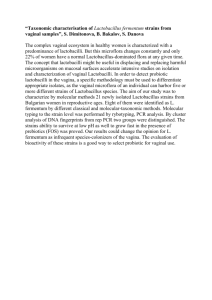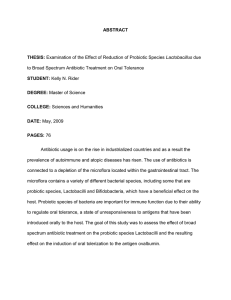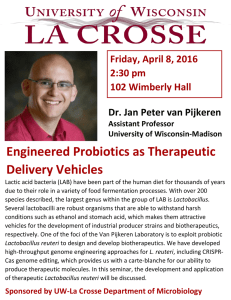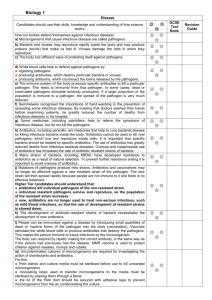International Journal of Animal and Veterinary Advances 4(6): 358-362, 2012
advertisement
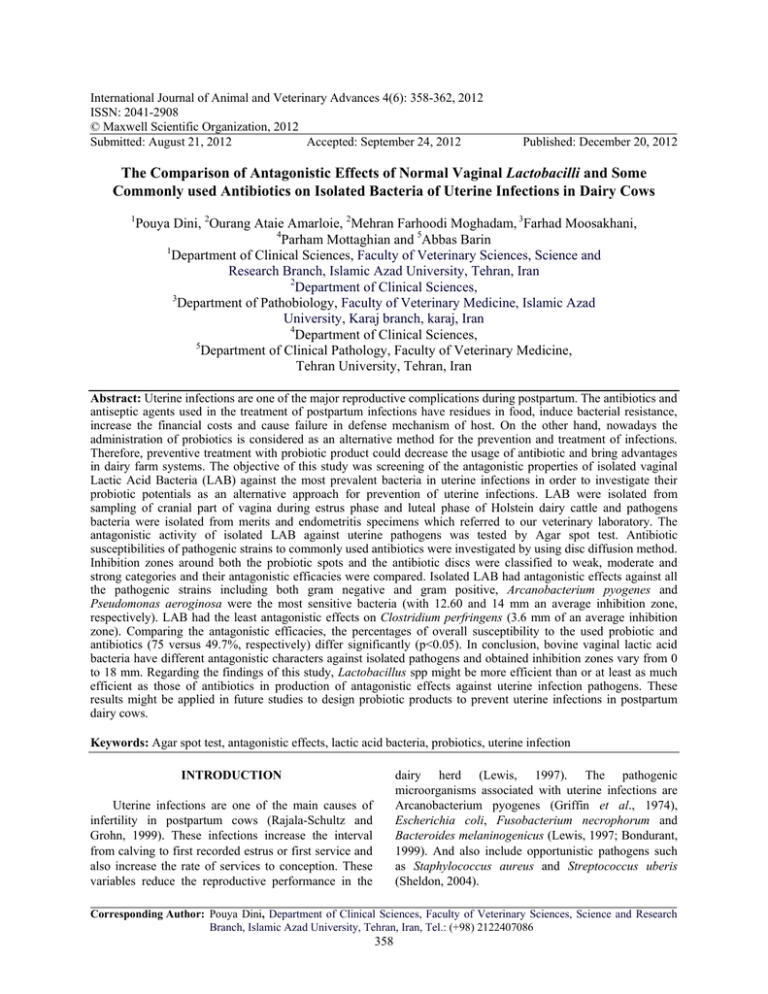
International Journal of Animal and Veterinary Advances 4(6): 358-362, 2012 ISSN: 2041-2908 © Maxwell Scientific Organization, 2012 Submitted: August 21, 2012 Accepted: September 24, 2012 Published: December 20, 2012 The Comparison of Antagonistic Effects of Normal Vaginal Lactobacilli and Some Commonly used Antibiotics on Isolated Bacteria of Uterine Infections in Dairy Cows 1 Pouya Dini, 2Ourang Ataie Amarloie, 2Mehran Farhoodi Moghadam, 3Farhad Moosakhani, 4 Parham Mottaghian and 5Abbas Barin 1 Department of Clinical Sciences, Faculty of Veterinary Sciences, Science and Research Branch, Islamic Azad University, Tehran, Iran 2 Department of Clinical Sciences, 3 Department of Pathobiology, Faculty of Veterinary Medicine, Islamic Azad University, Karaj branch, karaj, Iran 4 Department of Clinical Sciences, 5 Department of Clinical Pathology, Faculty of Veterinary Medicine, Tehran University, Tehran, Iran Abstract: Uterine infections are one of the major reproductive complications during postpartum. The antibiotics and antiseptic agents used in the treatment of postpartum infections have residues in food, induce bacterial resistance, increase the financial costs and cause failure in defense mechanism of host. On the other hand, nowadays the administration of probiotics is considered as an alternative method for the prevention and treatment of infections. Therefore, preventive treatment with probiotic product could decrease the usage of antibiotic and bring advantages in dairy farm systems. The objective of this study was screening of the antagonistic properties of isolated vaginal Lactic Acid Bacteria (LAB) against the most prevalent bacteria in uterine infections in order to investigate their probiotic potentials as an alternative approach for prevention of uterine infections. LAB were isolated from sampling of cranial part of vagina during estrus phase and luteal phase of Holstein dairy cattle and pathogens bacteria were isolated from merits and endometritis specimens which referred to our veterinary laboratory. The antagonistic activity of isolated LAB against uterine pathogens was tested by Agar spot test. Antibiotic susceptibilities of pathogenic strains to commonly used antibiotics were investigated by using disc diffusion method. Inhibition zones around both the probiotic spots and the antibiotic discs were classified to weak, moderate and strong categories and their antagonistic efficacies were compared. Isolated LAB had antagonistic effects against all the pathogenic strains including both gram negative and gram positive, Arcanobacterium pyogenes and Pseudomonas aeroginosa were the most sensitive bacteria (with 12.60 and 14 mm an average inhibition zone, respectively). LAB had the least antagonistic effects on Clostridium perfringens (3.6 mm of an average inhibition zone). Comparing the antagonistic efficacies, the percentages of overall susceptibility to the used probiotic and antibiotics (75 versus 49.7%, respectively) differ significantly (p<0.05). In conclusion, bovine vaginal lactic acid bacteria have different antagonistic characters against isolated pathogens and obtained inhibition zones vary from 0 to 18 mm. Regarding the findings of this study, Lactobacillus spp might be more efficient than or at least as much efficient as those of antibiotics in production of antagonistic effects against uterine infection pathogens. These results might be applied in future studies to design probiotic products to prevent uterine infections in postpartum dairy cows. Keywords: Agar spot test, antagonistic effects, lactic acid bacteria, probiotics, uterine infection dairy herd (Lewis, 1997). The pathogenic microorganisms associated with uterine infections are Arcanobacterium pyogenes (Griffin et al., 1974), Escherichia coli, Fusobacterium necrophorum and Bacteroides melaninogenicus (Lewis, 1997; Bondurant, 1999). And also include opportunistic pathogens such as Staphylococcus aureus and Streptococcus uberis (Sheldon, 2004). INTRODUCTION Uterine infections are one of the main causes of infertility in postpartum cows (Rajala-Schultz and Grohn, 1999). These infections increase the interval from calving to first recorded estrus or first service and also increase the rate of services to conception. These variables reduce the reproductive performance in the Corresponding Author: Pouya Dini, Department of Clinical Sciences, Faculty of Veterinary Sciences, Science and Research Branch, Islamic Azad University, Tehran, Iran, Tel.: (+98) 2122407086 358 Int. J. Anim. Veter. Adv., 4(6): 358-362, 2012 The traditional antimicrobial treatment applied for these infections might lack efficacy and does not improve the reproductive performance of the treated animals (Gilbert and Schwark, 1992). The antibiotics and antiseptic agents used in the treatment of acute postpartum uterine infections induce residues in foods, spread of bacterial resistance and increase in financial costs and failures in defense mechanisms of the host (Lewis, 1997; Otero, 2006). Preventive treatment with probiotic products could decrease the use of antibiotics in dairy farming systems. Lactic acid bacteria are the most common type of microbes used as probiotics. The mechanisms involved in competitive exclusion by which the probiotic microorganisms exert their antagonistic effects against pathogenic bacteria are multi factorial and include regulatory forces exerted by the host, the diet and the microbes. Some of the major microbial factors include competition for attachment sites, low PH, low redox Potential and elaboration of antimicrobial substances (e.g., VFA, lactic acid and bacterocins). The human vaginal macrobiotic is a complex community of microorganisms in which Lactic Acid Bacteria (LAB) play a fundamental role (Sobel, 1999; McLean, 2003). The presence-absence of LAB and particularly Lactobacilli is considered a health-disease indicator and its predominant role in this ecological niche is now well recognized (Reid and Bruce, 2001, 2006). Lactobacilli are present in the vaginal micro flora of healthy cows (Otero, 2001; Nader-Macías, 2008). The genus Lactobacillus is the largest group among the lactic acid bacteria (Nader-Macías, 2008). They can prevent pathogen colonization by mechanisms such as the production of antagonistic substances such as lactic acid, H 2 O 2 , or bacteriocins (Ocana et al., 1999; Ito et al., 2003; Otero et al., 2006). The objective of the present study was to investigate the antagonistic effects of isolated Lactobacilli from vaginal microbiota against common uterine infectious pathogens in vitro. signs of disease in any of the animals. The vulvar area was washed with povidone-iodine and water and then a double guard swab was inserted into the vagina to sample the most anterior area (fornix). Samples were collected in BHI (Merck co., inc.) broth as a transfer media. Isolation and identification of microorganisms: Isolated Lactobacilli were pooled and enriched in BHI broth for 48 h in 37°C and then the culture were centrifuged and the sediment were incubated on MRS agar in 5% atmospheric CO 2 for 5 days. Identification to genus level was performed by morphological characteristics, Gram staining, catalase reaction, NO 3 reduction and indol production. Pathogenic microorganisms: Pathogenic strains were isolated from uterine infection specimens referred to the laboratory. These strains were identified using standard phenotypic methods. The isolated pathogenic strains used as indicators in agar spot test are listed below: Arcanobacterium pyogenes, Escherichia coli, Clostridium perfringens, Staphylococcus aureus, Streptococcus uberis, Proteus mirabilis, Pseudomonas aeroginosa and Klebsiella pneumonia. All the pathogenic strains except E. coli were inoculated in BHI agar. E. coli was inoculated in Nutrient agar (Merck and Co., Inc). Then, the plates were incubated either an aerobically or aerobically depending on the growth characteristics of each indicator pathogenic strain at 37°C. Bacterial strains and culture conditions: Lactobacillus strains were isolated from bovine vaginal samples and subculture in microaerophilic condition (5% CO 2 , C type gas pack) in MRS (Merck & co., inc.) broth at 37°C for 12 to 14 h. Due to the short duration of the experiment, the strain was preserved using serial cultures. In vitro antimicrobial activity: An agar spot test was performed to evaluate the potential of isolates to inhibit pathogenic bacteria (Jacobsen et al., 1999). Fresh cultures of isolated Lactobacilli were spotted (2 .5 µL) on the surface of MRS agar (15 mL in 8 cm diameter plates) and incubated an aerobically for 24 h at 30°C to develop the spots. Then, the plate surface was covered with 10 mL of BHI agar inoculated with the indicator bacteria (1×107 cfumL). The plates were incubated either anaerobically or aerobically depending on the growth characteristics of each indicator pathogenic strain at 37°C. After 24 to 48 (for Streptococcus spp.) hours of incubation, inhibition zones were determined. The inhibition zones were classified as (-) for no visible inhibition, (+) for 0.5 to 6 mm, (++) for 7 to 12 mm and (+++) for more than 12 mm (PereaValez et al., 2007). Each test was performed five times with different isolates of each pathogen obtained from different cows. Sampling vaginal bacterial flora: Samples were obtained from 14 cows during the estrus phase of the estrous cycle and 14 cows without any signs of estrus. Neither vaginoscopy nor clinical examination revealed Antibiotic susceptibility test: Two sets of pathogenic isolates were chosen from the total number of pathogens obtained and their antibiotic susceptibilities were assessed. Antimicrobial susceptibility testing was MATERIALS AND METHODS 359 Int. J. Anim. Veter. Adv., 4(6): 358-362, 2012 performed by using routine disk diffusion technique. A total of 21 commonly used antibiotics discs were used, which their antibiotic concentrations are listed as follows: Tetracycline (30 µg), Cefquinome (10 µg), Ceftiofur (30 µg), Penicillin (10 IU), Cloxacillin (1 µg), Tylosin (30 µg), Enrofloxacin (5 µg), Lincomicin (2 µg), Gentamicin (30 µg), Novobiocin (30 µg), Florfenichol (30 µg), Sultrim (TrimetoprimSulfadiazine) (25 µg), Trimetoprim-sulfamethoxazole (25 µg), Lincospectin (15 µg), Neomycin (30 µg), Kanamycin (30 µg), streptomycin (10 µg), Ampicillin (10 µg), Amoxycillin (10 µg), TETRA-DELTA (Mixture of 25 µg Streptomycin, 30 µg Neomycin, 30 µg Novobiocin, 10 IU Penicillin) and Nafpenzal (35 µg). against Pseudomonas aeroginosa (an average inhibition zone of 14 mm). The least antagonistic activity was shown against Clostridium perfringens (an average inhibition zone of 3.6 mm). Considering average inhibition zones, Lactobacillus spp produced strong antagonistic activity against Pseudomonas aeroginosa, Arcanobacterium pyogenes. Moderate positive antagonistic effect was showed against Escherichia coli, Proteus mirabilis, Klebsiella pneumonia, Staphylococcus aureus and Streptococcus uberis. Lactobacillus spp. showed weak positive antagonistic activity against Clostridium perfringens (Table 1 and 2). Antibiotic susceptibility of pathogenic strains: Among 21 used antibiotics, ceftiofur, Linco-spectin and florfenicol were more effective against pathogenic strains. Generally among the pathogenic strains, Proteus mirabilis had the least (11.9%) and Arcanobacterium pyogenes (47.6%) and Clostridium perfringens (42.8%) had the most percentages of complete susceptibility to the antibiotics used. Table 3 represents the percentages of overall resistance, moderate susceptibility and complete susceptibility of pathogens to each antibiotic. Statistical analysis: As mentioned above, the pathogenic isolates were categorized based on the measured inhibitory zones around their colonies; thus it became possible to compare and statistically analyze these categories with the routinely used system to categorize the antibiotic susceptibility of any pathogen. The statistical analysis was performed by SPSS 16.0 software. Obtained data were analyzed using Chi square test to compare antagonistic efficacy of vaginal Lactobacilli and antibiotics. p<0.05 was regarded as significant. DISCUSSION The inhibitory effect of Lactic Acid Bacteria (LAB) is mainly due to the accumulation of main primary metabolites such as lactic acids and acetic acids, ethanol and carbon dioxide. Additionally, LAB are also capable of producing antimicrobial compounds such as formic and benzoic acids, hydrogen peroxide, diacetyl, acetoin and bacteriocins (Otero et al., 2006). RESULTS Antagonistic activity of isolated Lactobacilli against pathogenic strains: By comparing the average of inhibition zones, it was shown that isolated Lactobacilli produced positive antagonistic activity against all the pathogens. The greatest antagonistic activity was shown Table 1: Average inhibition zone diameters against uterine pathogens Pathogens Culture 1 Culture 2 Arcanobacterium pyogenes 14* 5 Clostridium perfringens 4 0 Escherichia coli 15 6 Klebsiella pneumonia 14 7 Proteus mirabilis 13 6 Pseudomonas aeroginosa 17 7 Staphylococcus aureus 13 5 Streptococcus uberis 9 0 *: All values in millimeters Table 2: Statistical analysis of obtained data Pathogens Mean±S.E. Pseudomonas aeroginosa 14.00*±2.025 Arcanobacterium pyogenes 12.60±1.913 Escherichia coli 11.40±1.600 Proteus mirabilis 10.80±1.393 Klebsiella pneumonia 10.60±2.064 Staphylococcus aureus 9.60±1.400 Streptococcus uberis 7.00±1.817 Clostridium perfringens 3.60±0.927 *: All values in millimeters; Min.: Minimum; Max.: Maximum S.D. 4.527 4.277 3.577 3.114 4.615 3.130 4.062 2.073 360 Culture 3 14 5 12 8 11 16 11 9 Min. 7 5 6 6 7 5 0 0 Culture 4 15 5 14 17 14 18 11 10 Max. 18 15 15 14 17 13 10 5 Culture 5 15 4 10 7 10 12 8 7 Classification +++ +++ ++ ++ ++ ++ ++ + Int. J. Anim. Veter. Adv., 4(6): 358-362, 2012 Table 3: Percentages of overall resistance, moderate susceptibility and complete susceptibility of pathogens to antibiotics Intermediate Intermediate Antibiotics Resistant susceptibility Susceptible Antibiotics Resistant susceptibility Amoxicillin 62.50 12.50 25 Tylosin 75 18.75 Ampicillin 56.25 18.75 25 Neomycin 100 0 Cefquinome 6.250 12.50 81.25 Novobiocin 68.75 18.75 Ceftiofor 0 0 100 Penicillin 75 0 Cloxacillin 100 0 0 Streptomycin 75 25 Enrofloxacin 6.250 25 68.75 Sultrim 75 18.75 Florfenicol 0 6.250 93.75 Tetracycline 50 34.25 Gentamicin 68.75 25 6.250 Tri-Sulfa 75 18.75 Kanamycin 68.75 31.25 0 Nafpenzal 6.25 25 Lincomycin 87.50 12.50 0 Tetra-Delta 0 25 Lincospectin 0 0 100 Table 4: Overall percentages of complete susceptibility, intermediate susceptibility and resistance of pathogenic strains to Lactobacillus spp and antibiotics Antagonistic Susceptible Intermediate Resistant activity pathogens susceptibility pathogens Lactobacillus spp 37.5 37.5 25 Antibiotics 34.2 15.5 50.3 Susceptible 6.250 0 12.50 25 0 6.250 18.75 6.250 68.75 75 In our study, antagonistic efficacy of isolated LAB against isolated pathogens was compared with antagonistic efficacy of commonly used antibiotics. Negative and weak positive antagonistic activities were considered as resistance; Moderate positive was considered as intermediate susceptibility and strong positive antagonistic activity as complete susceptibility. Table 4 presents calculated percentage of complete and intermediate susceptibility and also resistance of pathogenic strains to isolated Lactobacilli and antibiotics. It should be mentioned that due to different natures of antibiotics and probiotics, it is impossible and impractical to compare inhibition zone diameters formed around colonies of our LAB with those formed around antibiotic discs. However, their efficacy to suppress the proliferation of pathogenic strains is comparable. Overall results show that 50.3% of indicator pathogenic strains were resistant to antibiotics, whereas only 25% of pathogenic strains were resistant to antagonistic effects of Lactobacillus species. Among resistant pathogens, 5% was completely resistant to Lactobacillus spp and no inhibition zones were recorded for them. 75% (37.5% + 37.5%) of pathogens were susceptible to Lactobacillus spp whereas, 49.7% (34.2% + 15.5%) of pathogens were susceptible to antibiotics. The percentages of overall susceptibility to the used probiotic and antibiotics differ significantly (p<0.05). Despite the fact that there is a significant difference between the percentages of overall susceptibility, the percentages of complete susceptibility to the probiotic and antibiotics did not differ substantially. Therefore, considering the percentages of susceptibility to the used probiotic and antibiotics, it can be concluded that Lactobacillus spp. might be more efficient than or at least as much efficient as those of antibiotics in production of antagonistic affects against uterine infection pathogens. In sum, according to the obtained results and also comparison of the antagonistic efficacy of probiotics and antibiotics, we concluded that in vitro growth The production levels and the proportions among those compounds depend on the strain, medium compounds and physical parameters (Tannock, 2004). It has been shown, due to the effect of protease sensitive bacteriocins, Gram positive pathogens were the most sensitive bacteria to the LAB (Jack et al., 1995). However LAB were also able to control the growth of Gram negative pathogens including food borne pathogens by the production of organic acids and hydrogen peroxide (Lu and Walker, 2001; Ito et al., 2003). In this study, the range of measured inhibition zone diameters in general was wide (0 mm minimum to 18 mm maximum) at the same time it varied greatly for individual species of pathogens. These findings might suggest the importance of variations between strains of one species. Moreover, in the second set of cultures as it`s shown in Table 1, the amount of inhibition zone was completely differ from remaining sets, which could be due to the culture process. Likewise the statement of Ito et al. (2003), Isolated Lactobacilli produced relatively greater antagonistic effects against gram negative bacteria than gram positive bacteria. This finding was in contrast with the statement by jack et al. (1995) Fraga et al. (2008) showed that lactic acid bacteria (Lactobacillus and Enterococcus strains) isolated from mare vagina produced antagonistic effects against Staphylococcus aureus as a representative of gram positive bacteria and Escherichia coli as a representative of gram negative bacteria. Similarly in our study isolated Lactobacilli were able to inhibit the growth of both Staphylococcus aureus and E. coli. It is obvious that the similarities or differences between results obtained by various studies might be rooted in similarities or differences between probiotic strains and also between indicator pathogenic strains. 361 Int. J. Anim. Veter. Adv., 4(6): 358-362, 2012 McLean, N.W., 2003. Characterization and selection of a lactobacillus species to re-colonies the vagina of women with recurrent bacterial vaginosis. J. Med. Microbial., 49: 543-552. Nader-Macías, M.E., M.C. Otero, M.C. Espeche and N.C. Maldonado, 2008. Advances in the design of probiotic products for the prevention of major diseases in dairy cattle. J .Ind. Microbiol. Biotechnol., 35(11): 1387-1395. Ocana, V.S., A.A. Pesce de Ruiz Holgado and M.E. Nader-Macias, 1999. Characterization of a bacteriocin-like substance produced by a vaginal Lactobacillus salivariusstrain. Appl. Environ. Microbiol., 65(12): 5631-5635. Otero, M.C., 2001. Vaginal bacterial microflora modifications during the growth of healthy cows. Lett. Appl. Microbiol., 31: 251-254. Otero, M.C., 2006. Inhibition of staphylococcus aureus by H 2 O 2 -producing lactobacillus gasseri isolated from the vaginal tract of cattle. Anim. Reprod. Sci., 96: 35-46. Otero, M.C., L. Morelli and M.E. Nader-Macias, 2006. Probiotic properties of vaginal lactic acid bacteria to prevent metritis in cattle. Appl. Microbiol., 43: 91-97. PereaValez, M., K. Hermans, T.L. Verhoeven, S.E. Lebeer, J. Vanderleyden and S.C. De Keersmaecker, 2007. Identification and characterization of starter lactic acid bacteria and probiotics from Columbian dairy products. J. Appl. Microbiol., 103: 666-674. Rajala-Schultz, P.J. and Y.T. Gro¨hn 1999. Culling of dairy cows. Part I. Effects of diseases on culling in Finnish Ayrshire cows. Prev. Vet. Med., 41: 195-208. Reid, G. and A.W. Bruce, 2001. Selection of Lactobacillus strains for urogenital probiotic applications. J. Infect. Dis., 183 (Suppl. 1): S77-S80. Reid, G. and A.W. Bruce, 2006. Probiotics to prevent urinary tractinfections: The rationale and evidence. World. J. Urol., 24: 28-32. Sheldon, I.M., 2004. The postpartum uterus. Vet. Clin. North Am. Food Anim. Pract., 20:569-591. Sobel, J.D., 1999. Is there a protective role for vaginal flora? Curr. Infect. Dis. Rep., 1: 379-383. Tannock, G.W., 2004. A special fondness for Lactobacilli. Appl. Environ. Microbiol., 70(6): 3189-3194. inhibition of uterine pathogens by probiotic potency of lactobacilli spp. might contribute to the development of in vivo approaches for treatment and prevention of bovine uterine infection. Hence our results might be applied in future studies to design probiotic products to prevent uterine infections in postpartum dairy cows. REFERENCES Bondurant, R.H., 1999. Inflammation in the bovine female reproductive tract. J. Anim. Sci., 77: 101-110. Fraga, M., 2008. Vaginal lactic acid bacteria in the mare: Evaluation of the probiotic potential of native lactobacillus spp. and enterococcus spp. strains. Antonie. Leeuw., 93(1-2): 71-78 Gilbert, R.O. and W.S. Schwark, 1992. Pharmacological considerations in the management in the peripartumconditions in the cow. Vet. Clin. North Am. Food. Anim. Pract., 8(1): 29-56. Griffin, J.F.T., P.J. Hartigan and W.R. Nunn, 1974. Non-specific uterine infection and bovine fertility. Theriogenology, 1(3): 107-104 Ito, A., Y. Sako, S. Kudo, S. Sato and H. Nakajima, 2003. The screaning of hydrogen-producing lactic acid bacteria and their application to inactivating psychotrophic food-borne pathogens. Curr. Microbiol., 47: 231-236. Jack, R.W., J.R. Tagg and B. Ray, 1995. Bacteriocins of gram-positive bacteria. Microbiol. Rev., 59(2): 171-200. Jacobsen, C.N., N. Rosenfeldt, A.E. Hayford, P.L. Møller, K.F. Michaelsen, A. Pærregaard, B. Sandstro¨m, M. Tvede and M. Jakobsen, 1999. Screening of probiotic activities of forty-seven strains of Lactobacillus spp. by in vitro techniques and evaluation of the colonization ability of five selected strains in humans. Appl. Environ. Microbiol., 65(11): 4949-4956. Lewis, G.S., 1997. Uterine health and disorders. J. Dairy, Sci., 80(5): 984-994. Lu, L. and W.A. Walker, 2001. Pathologic and physiologic interactions of bacteria with the gastrointestinal epithelium. Am. J. Clin. Nut. 73(Suppl): 1124-1130. 362
